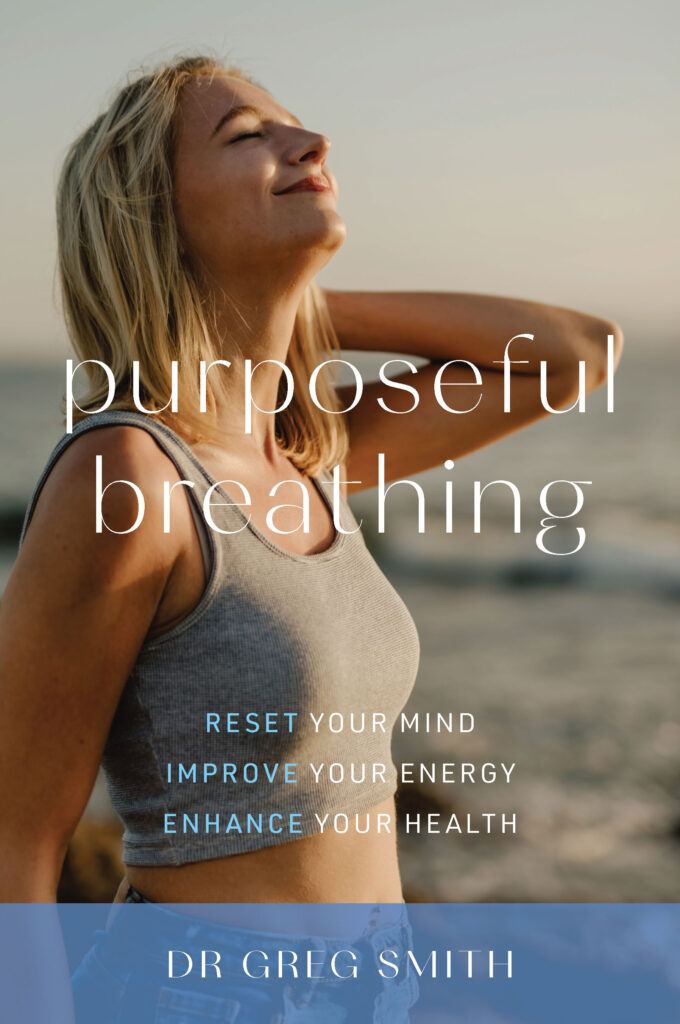Do you want to learn to uplift your energy to take on the world? Or perhaps you are looking for a tool to help calm an anxious mind or deal with depression?
Dr Greg Smith is an experienced psychologist, and his new book Purposeful Breathing (Exisle 2020) is a masterclass in taking control of your mind and body using your most underrated superpower, your breath. Grounded in practical examples and illustrated by case studies, this book melds Eastern traditions and Western science to give you access to the life-changing power of breathing with control and purpose.
In the following extract, Greg describes the basic principles of breathing with purpose to help take control of your physical and mental health:
When using the breath as a way to change mood and energy level, there are a few principles to bear in mind that are helpful, and which inform the styles of breathing for particular purposes [in the section that follows].
Do something different
There are whole approaches to therapy based on the principle of ‘When there is a problem, do something different’. The same applies to breathing.
If you want to change how you are feeling, take a moment to notice your breathing and change it. If your breathing is fast and shallow, make it slower and deeper. If it is jumpy, make it even, and so on.
• Breathing deep and diaphragmatically rather than high in the chest has a calming effect.
• The slower the breath the more calming it is, as long as it stays reasonably comfortable, of course, not so slow as to be purposeful breathing forced or make you short of breath.
• Extending the exhalation is calming. Longer exhalations activate the relaxation response of the body.
• Having the in- and out-breaths about the same length also helps bring a sense of being calm and centred. Although it is a subtle effect, having the in-breath longer than the out-breath tends to raise people’s energy, and having the out-breath longer than the in-breath tends to lower energy. While you can choose to have longer exhalations to relax or longer inhalation to energise, keeping it even is usually simple and helpful.
• Breathing in and out for about five or six seconds each brings balance. The length of the breath is important. Ingeneral, the slower you breathe, the calmer the effect of thebreathing, as long as you stay within comfortable limits — ifyou force it to be too slow it will be uncomfortable, and then you’ll tense up. When you stop to focus on the breath, an ideal is to breathe for about five or six breaths per minute. This seems to strike a special resonance, a ‘sweet spot’ that brings a range of physical factors into balance.
Holding your breath
Often when people have strong, difficult emotions they unconsciously hold the breath, so it is better to be aware not to hold the breath, unless for a specific purpose. Instead, move from the in-breath to the out-breath, and the out-breath to the in-breath with only a relaxed, natural gap in between.
Holding the breath in or out tends to hold the emotional state of the moment. Breath holding, if you do it, should be careful and deliberate. If you are feeling down, for example, holding the breath may lift you up, and if over-breathing, then pausing after the exhalation will help restore the CO2 and O2 balance.
Focus on the breath
Focusing on the breath in itself tends to help with calming and centring because it helps to redirect the mind. When people are anxious, they typically have a lot of anxious thoughts, which then feed the anxiety. Focusing on the breath helps to interrupt this by moving you from a self-talk mode to a sensing mode.
Inhale to raise energy, exhale to lower energy
While in a literal sense the inhalation and exhalation must balance overall in volume, the length and focus of the breath make a difference. When the inhalation is longer than the exhalation, it tends to raise energy in the body.
When the exhalation is longer, it tends to lower energy. This happens spontaneously in people feeling anxious or depressed and they can consciously change it. Most of the time you will want balance, so will probably want your inhalation and exhalation to be about the same length. However, if you are feeling flat you can lengthen the inhalation, breathing in for, say, a count of eight and out for a count of four. Make sure to keep within comfortable limits, not forcing the inhalation. If you are feeling overstimulated, anxious or on edge, you might lengthen the exhalation, breathing out for, say, a count of eight and in for a count of four.
Breathing to the front is more emotional; breathing to the back is more calming
The breath can be directed to the front of the body, the back or more to the centre.
If you breathe to the front of the body, it tends to be more emotional. You might want this if you have felt emotionally ‘blocked’. Breathing to the back tends to be more calming and more meditative. You can also consciously breathe so as to fill up the centre of the body. This is balanced and good for general activity.
Breath can link with posture
Bending forward is calming, while opening the chest (bending back) is energising.
Linked with the notion of breathing to the front or the back of the body is the practice of opening the front or the back more with movement. When you open the front of the body, such as by a yoga style backbend, it is energising. When you do a forward bend, opening the back of the body and closing in the front, it tends to be calming. In daily life, you tend to see posture reflect this. Depressed people are often slumped in their posture, with the front of the body closed and held in. Changing posture and opening the chest helps to lift mood and energise, such as with the old-fashioned advice to stand tall with shoulders back.
Holding the breath tends to hold or block energy
People who are depressed often sigh the breath out and unconsciously hold the breath out. People who are very stressed and having difficulty with a particular emotion often hold the breath, inadvertently blocking the emotion. We’ve probably all heard the phrase when facing a difficult challenge to ‘take a deep breath’ and then just do it. In practice, when people do this they often take the deep breath, then hold it a little. This lifts the energy and helps them step forward.
For people who are going through grief or depression, taking a deep breath and holding it lifts them a little. It is surprisingly difficult to stay quite so ‘down’ when you are holding a large full breath.
On the other hand, in therapy, people who are dealing with other powerful emotions often literally stop breathing for significant periods. Gently encouraging them to keep breathing allows them to work through the emotion more effectively.
Breathing can be soft and gentle or strong and muscular
Each of these breathing styles produces different effects, to be more calming or more energising.
Learning to breathe in a strong, muscular fashion is now a part of many athletes’ training regimes. Some approaches use an apparatus to provide resistance against the breath so the athlete has to work harder to get the breath in. In doing this the diaphragm is always central but the full range of chest and abdominal muscles can be engaged to add strength and endurance. The aim, of course, is that in those last minutes of the race or the game, the athlete can breathe more strongly so as to compete better.
The best breathing is balanced breathing
While best breathing will be responsive and vary according to the demands of the moment, in general the best breathing is balanced. It is not about breathing as hard or as fully as you can — it is easy to over-breathe. A sweet spot happens where the breath is slow and even, which leads to a sense of physical, mental and emotional balance.

About the author
Greg Smith has been a psychologist for over 35 years helping people to overcome difficulties with anxiety, depression, trauma, life crises and relationship issues. He has also taught counselling and psychotherapy at graduate level for many years. He combines this experience of psychotherapy with a focus on the positive psychology of human potential and has completed a doctorate on ‘Inspiration in Everyday Life’.
He is also a qualified yoga teacher and in recent years has studied the exciting developments through which Western science is beginning to provide explanations for many of the things known experientially in the East for so long.
His book Purposeful Breathing is available from www.exislepublishing.com and wherever good books are sold.



